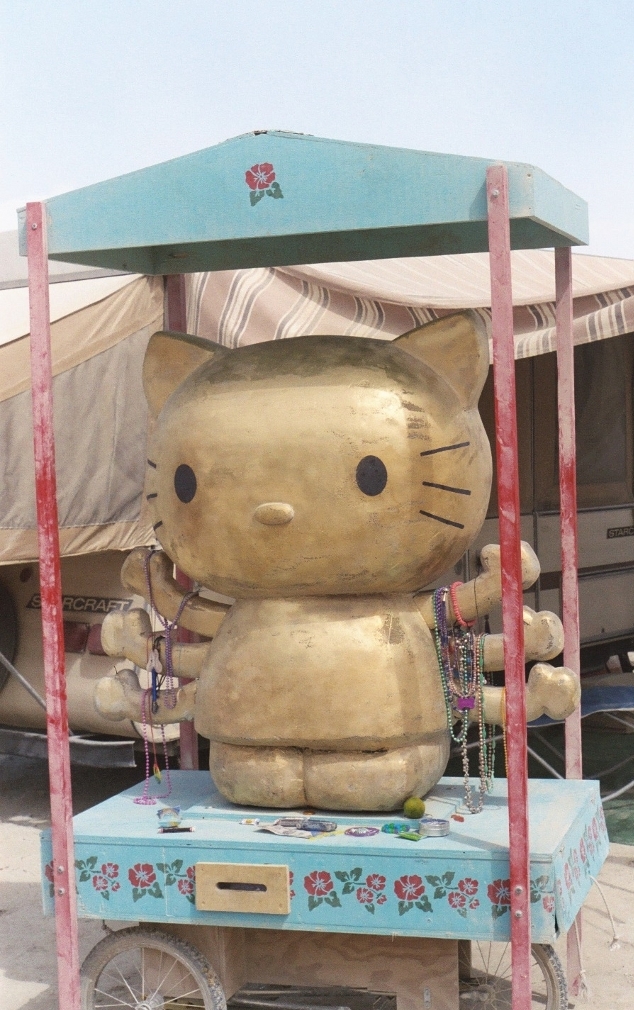This hyper-spectacle generates an energetic and continuous flow between chaos and order. Concepts and symbols originating within diverse cultural and religious traditions are playfully and creatively converged, forging ritualistic pathways towards catharsis, ecstasy, and insight. In addition to the definitive ritual bonfire, numerous other rites—both sincere and satirical—have transpired here: massive ephemeral temples dedicated to memory and mourning; anti-consumerist parodies of Christian evangelism; operatic performances invoking Vodou lwas; Shabbat services conducted in the skeleton of a gothic cathedral; reiki attunement sessions; labyrinths; yoga, meditation and kabballah classes—the list could go on and on. At Burning Man, the random flotsam of human history and global cultures washes up on the shores of the Black Rock playa for one week, and then washes back out as participants return to what they call the “default world,” having shared in an experience that often leaves residual traces on their sense of self and notions of culture. Burning Man renders the native hybridity and plasticity of cultures transparent, revealing the extent to which religions are not static, historically bound institutions, but rather lived, fluid constructions. Syncretism and bricolage are nothing new in the history of religions as the defining and transgressing of boundaries seems definitional to community. While conservative traditionalists tend to see such mongrel developments rather unfavorably, history shows that whenever diverse cultures and religions come into contact they inevitably adopt ideas, symbols, and performative modes from one another, while also retaining or rejecting other core elements—a process of retrenchment that is itself a dynamic response to change.
At Burning Man, embodiment and experience are emphasized over doctrine or ideology. For example, Burning Man’s founder and ongoing chief visionary, Larry Harvey, speaks of “immediacy” as akin to a sacred power, writing that through immediate experience “We seek to overcome barriers that stand between us and a recognition of our inner selves, the reality of those around us, participation in society, and contact with a natural world exceeding human powers.” In the beauty and essential simplicity of the Black Rock Desert—as well as in the visceral experience of its arid and demanding environment—Burners often report a transformative sense of the numinous. The desert evokes a potent mix of limitlessness and mystery, as well as time-honored themes of hardship and sacrifice that are deeply embedded in the Western cultural psyche. This juxtaposition between the vast, vacant landscape and human, artistic abundance fosters unique perceptions of space and time, both embodied and imaginal. Participants also frequently speak of community, self-expression, and self-reliance—echoing a set of ethical principles articulated by the event’s organizers—as interrelated themes. These dynamic encounters between self and other—in tandem with embodied experiences of the desert—coalesce to generate critical transformations for many participants, leading some to ascribe spiritual significance to this event.
For Burners, spirituality is fundamentally experiential (based on the primacy of personal experience and personal authority in framing those experiences), reflexive (inspiring reflections on self, self/other, self/nature, and self/culture), and heterodoxic (constituted by multiply-layered, fluid, and non-centralized constructions of meaning). But troubling any simplistic conclusions, many other participants state most emphatically that Burning Man does not entail any sense of spirituality—even while some of these same individuals also engage in expressive, ritualized quests for self-discovery through the event, but which they elect not to cloak in mystical terms. Furthermore, some observers and participants alike deny that this festival has any redeeming qualities whatsoever, seeing it as merely an excuse for debauchery and a license for transgressive behavior that is disconnected from any overt spirituality. Yet while the event is undeniably rife with opportunities for hedonistic indulgence, it would be mistaken to understand hedonism as anti-religious. Dismissals of Burners as pleasure-seekers reveal the deep and lasting imprint of America’s ascetic Protestantism. Furthermore, religious traditions that are utterly bereft of some opportunity for joyous, and occasionally excessive, celebration as part of the package deal are comparatively rare.
Page 2 of 3 | Previous page | Next page

